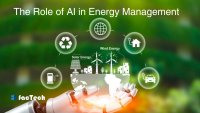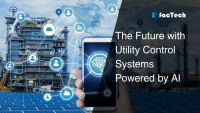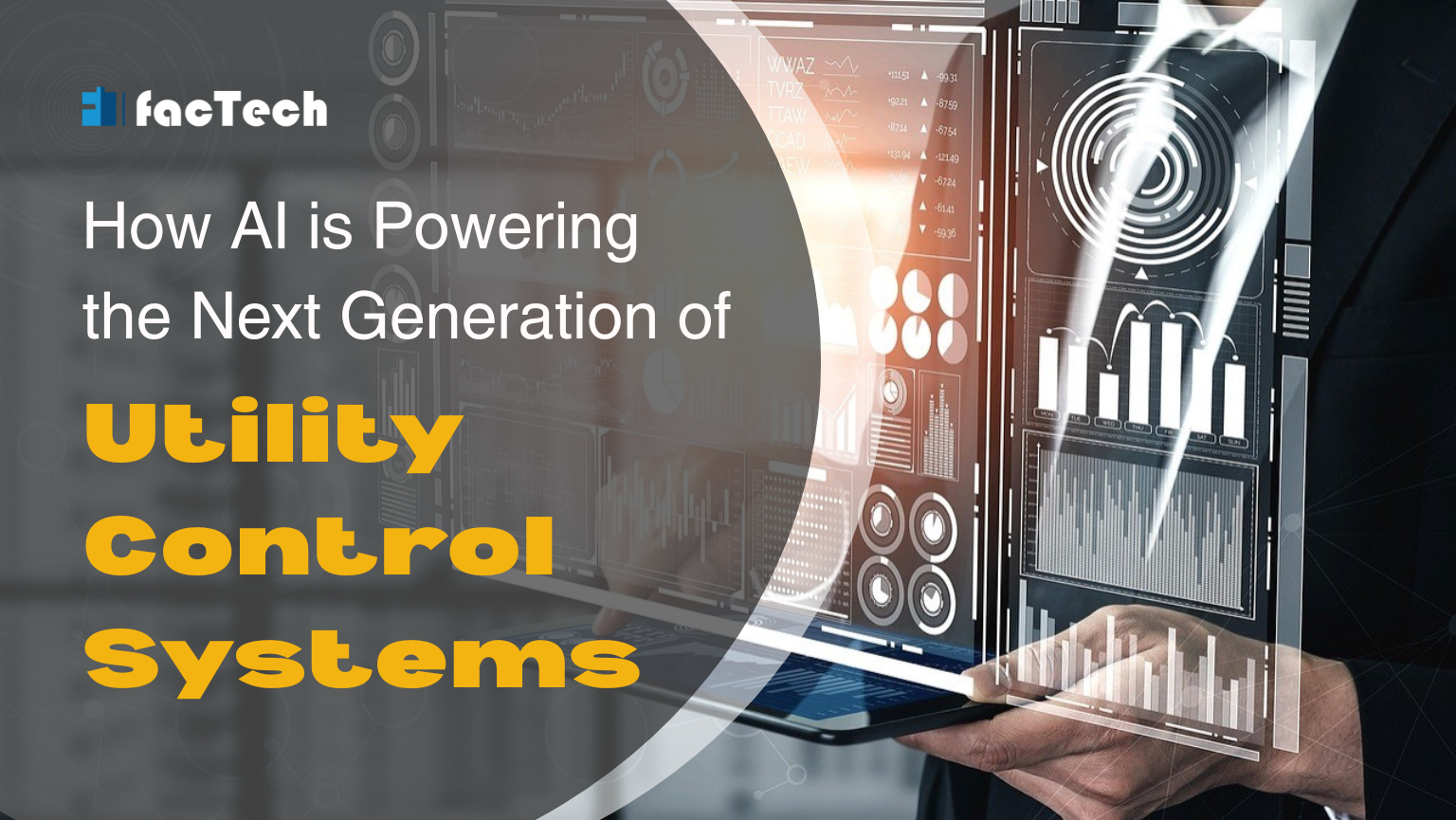How AI is Powering the Next Generation of Utility Control Systems
Facility managers have been forced to reconsider how they handle energy production, distribution, and consumption due to the changing environment and the escalating energy problem. AI has become a major force behind the energy sector’s change in spite of these obstacles. In a sector that must strike a balance between growing demand and environmental responsibility, its capacity to evaluate enormous datasets, spot trends, and make predictions promotes increased resilience and efficiency. It helps facility managers make better use of the resources and enhances the utility control system.

The Evolving Landscape of Utility Control System
Made to manage a single-source, centralized energy flow, conventional utility control systems were: following their generation by power plants, electricity was sent to consumers. Though successful at the time, this approach struggles to manage the complexity of modern society. Utilities deal with these among the primary problems:
Infrastructure Getting Older:
Many of the utility infrastructure around the globe is decades old, prone to failures, inefficiencies, and costly maintenance.
Including Renewable Energy:
Growing intermittent renewable energy sources like solar and wind power introduces significant fluctuations into the system that call for careful balancing measures.
Rising Demand:
Current systems are under great pressure as the global energy consumption rises.
Strong storms:
Climate change-induced more frequent and severe storms have the ability to substantially disrupt utility networks.
Cybersecurity Hazards:
As utility systems grow more digitalized and networked, hackers find easier access to them.
Consumer Expectations:
Consumers want more dependability, openness, and customized knowledge on their energy consumption more and more.
Reactive operations have to give way to proactive, predictive, and finally autonomous systems if we are to solve these challenges. Artificial intelligence (AI) is the layer of intellect allowing this transformation.

The Role of AI in Energy Management
As the world’s energy demand increases due to growing urbanization and industrialization, it is more important than ever to make the shift to more intelligent energy management. The five main facets of AI’s contribution in this shift are energy use optimization, efficiency enhancement, waste reduction, energy demand forecasting, and sustainability. Addressing the energy challenges of the present and the future requires these foundations.
Also, read How AI Improving Facility Management.
Maximizing Energy Use and Efficiency
Inefficiencies can cause too high prices and needless strain on power infrastructure as cities grow quickly and businesses use more energy than before. While ensuring utilities satisfy energy needs sustainably, AI-driven technologies are enabling solutions for these problems.
Smart power grids, for instance, dynamically change distribution depending on usage patterns by forecasting energy demand using machine learning data. These systems guarantee precise delivery of electricity when and where needed by considering weather conditions, grid load, and user behavior to lower costs and energy losses.
AI-driven management systems optimize energy use in residential and commercial buildings at the consumer level. By taking occupancy, time of day, and outside factors into account, these systems regulate lighting, heating, and cooling, improving comfort while reducing wasteful energy use and heating and cooling costs.
Predictive Maintenance
Predictive maintenance is among the most instantly useful and powerful uses of artificial intelligence in utility control. Maintenance was historically planned either after a failure or at set intervals. Often this resulted in unanticipated outages, early replacements, or expensive downtime.
Predictive maintenance systems driven by artificial intelligence monitor real-time conditions using data from many sensors on equipment like transformers, electrical lines, pumps, and pipes. Analyzing this data, machine learning techniques look for minor deviations, trends, and deteriorating patterns suggesting possible problems.
Motivating Sustainability
By enhancing the integration and efficiency of renewable sources like solar and wind, artificial intelligence not only maximizes energy use and lowers waste but also speeds sustainability initiatives. AI-powered systems in wind energy, for instance, forecast wind patterns and power generation so utilities may better match supply with demand and maximize energy storage.
AI forecasts sunshine levels in solar energy based on weather data, therefore enabling utilities to balance energy demands and enhance grid stability in times of irregular sunlight. It improves water reservoir management in hydropower by forecasting water flow and streamlining turbine operations for best efficiency. AI lessens dependency on fossil fuels and speeds the shift to greener, more efficient energy generation by optimizing the use of renewable energy sources.

The Future with Utility Control Systems Powered by AI
Looking ahead, the effect of artificial intelligence on utility control systems will only become more profound. We are headed for:
Greater Autonomous Grids:
Systems able to forecast as well as to independently act and change with the times.
More Decentralization:
By helping microgrids and localized energy systems be managed, artificial intelligence will increase resilience and local control.
Digital Twins:
Before actual alterations are carried out, very precise simulations, predictive modeling, and optimal planning enabled by AI-powered digital twins of whole utility networks will be possible.
Improved objectives for sustainability:
By maximizing renewable energy integration, lowering waste, and increasing energy efficiency across the whole value chain, artificial intelligence will be key in reaching aggressive decarbonizing ambitions.
Factech’s Dedication to Utility AI
At Factech, we are dedicated to providing utilities with modern artificial intelligence solutions. Our leadership in this shift comes from our emphasis on using artificial intelligence, especially generative artificial intelligence, for operational optimization, predictive maintenance, and asset management. We think that by adopting artificial intelligence, utility businesses may not only solve present problems but also create a more sustainable, strong, and efficient future for resource management and energy.
Already here, the next generation of utility control systems runs on artificial intelligence. Are you ready to realize its possibilities? Contact us to get a free demo.
FAQs
Q: What are the key obstacles conventional utility control systems must overcome?
Traditional utility control systems battle aging infrastructure, integrating intermittent renewable energy sources, rising demand, extreme weather events, increasing cybersecurity risks, and changing customer expectations for dependability and openness.
Q: In what ways may artificial intelligence raise utility control energy efficiency?
By running smart grids that dynamically change distribution depending on demand forecasts and real-time conditions and by automating energy use in buildings using lighting, heating, and cooling depending on occupancy and external conditions, artificial intelligence improves energy efficiency.
Q: In utility control driven by artificial intelligence, what part does predictive maintenance play?
Using artificial intelligence to examine equipment sensor data, predictive maintenance finds minute trends and possible faults before they start. This lets utilities plan maintenance ahead of time, lower expensive downtime, maximize equipment lifetime, and raise general safety.
Q: In what ways may artificial intelligence support energy sector sustainability?
By maximizing the integration and efficiency of renewable energy sources like solar and wind, projecting generating patterns, and simplifying operations, artificial intelligence greatly increases sustainability. This lessens dependence on fossil fuels and speeds the shift to more environmentally friendly energy generation.












